Tech
Photo quality comparison: Samsung Galaxy Note 20 versus iPhone 11 Pro – AppleInsider

Samsung’s latest and greatest smartphones have arrived in the form of the Note 20 and the Note 20 Ultra, so AppleInsider compared their spectacular cameras with Apple’s own iPhone line to find the better snapper.
We were thrilled to get our hands on the new Note devices, with Samsung touting some amazing new upgrades for the cameras. Between the high resolution, incredible zoom, and 8K video, there was a lot to check out, so we hit the road to capture some stellar shots that show off the camera’s abilities.
While there are some sample images included in the piece, check out the video for all our test shots.
A look at the specs
For this comparison, we’ll be taking a look at the Galaxy Note 20, the Galaxy Note 20 Ultra, as well as the iPhone 11 Pro. The iPhone 11 Pro and iPhone 11 Pro Max have the same lens setup, so photos taken with one will look the same as if shot on the other.
One thing to remember is the iPhones are now roughly a year old, with iPhone 12 inching closer to release. This is still a useful comparison, however, as the iPhone 11 line will be around for some time, and is still the most current iPhone to compare against.
Taking a closer look at the cameras, all devices sport a 12MP ultra-wide angle lens. It’s the other lenses where it gets interesting.
The Samsung Galaxy Note 20 sports a 12MP wide-angle lens as well as a 64MP tele lens. Those two lenses combined are able to offer 3X hybrid zoom as well as a maximum of 30X digital zoom.
The Samsung Galaxy Note 20 Ultra is packed with a 108MP wide-angle lens alongside a 12MP tele lens. It is able to obtain 5X optical zoom and 50X digital zoom.
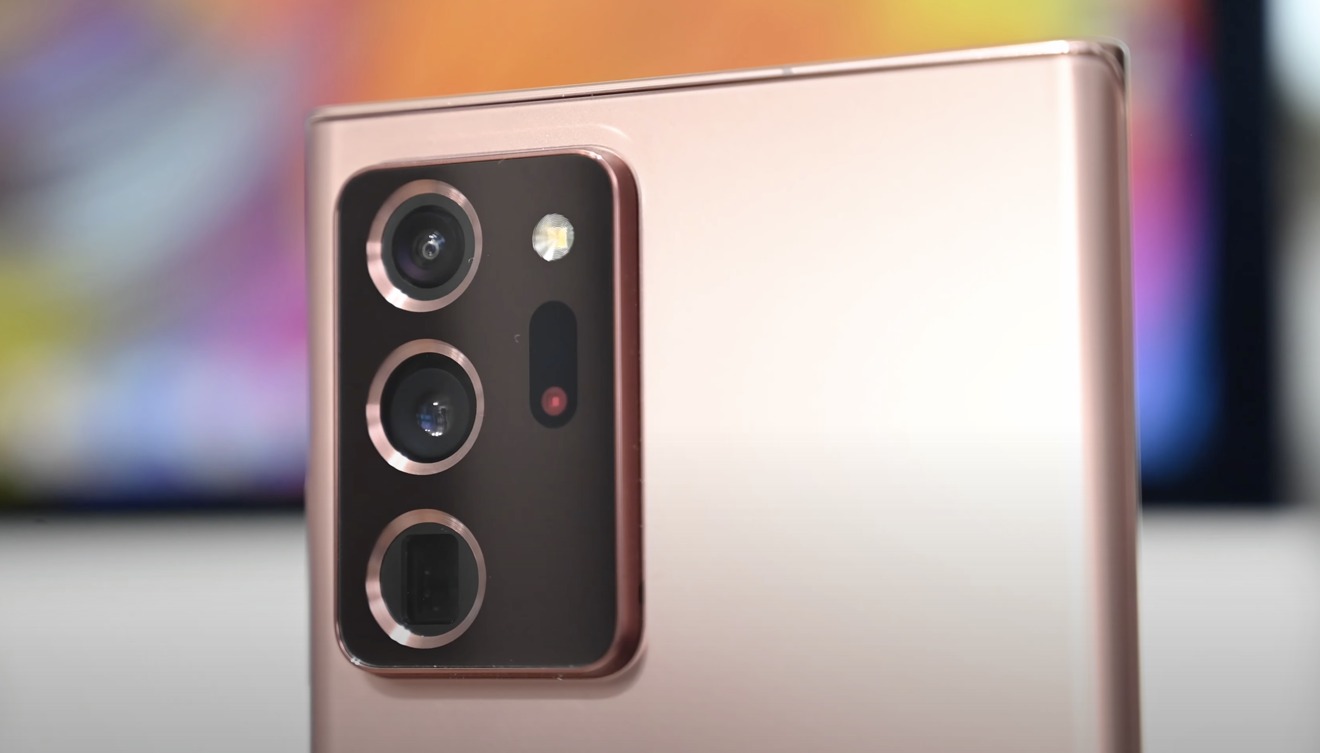

It is good to see that Samsung listened to its audience and pulled back from the 100X “super zoom” offered with the S20 line. Photos produced at 100X were grainy at best, and largely unusable.
Apple’s iPhone 11 Pro and iPhone 11 Pro Max both have 12MP wide and 12MP tele leness with 2X optical zoom and 10X digital zoom.
Photo tricks
Portrait mode, 108MP mode, live focus, panorama,
It seems each year there are more and more facets to these cameras just in the stock camera apps let alone with third-party apps can pull off. We don’t want to spend too much time on all of these, but wanted to give some general impressions of our time using them.
Both phones still include a portrait-like shooting mode, which Apple calls Portrait mode and Samsung calls Live Focus. These haven’t changed much since the last phones we tested.
Samsung still leans towards the “fun” side with effects such as swirls of the background as well as the normal blur. Apple has focused very much on replicating real-world lighting effects and as a general rule creates a more polished looking picture.
Which is better depends on which style you prefer.


Panoramas are also a common shooting mode. We took a few sample pics across the phones and did our best to keep the same speed each time, yet, the photos ended up entirely different sizes.
The iPhone’s picture was the widest while the Note 20 was the most compact, and the Note 20 Ultra was somewhere in between. I prefer the wider look to these, because the more compact the image, the more distortion is apparent in tighter shots.
The wider shots also lend themselves more to large prints.
The final special feature we wanted to touch on was the impressive 108MP mode of the Note 20 Ultra. While it has that many megapixels packed onto the sensor, by default it shoots in a much more reasonable size, but User have the option to enable that massive 108MP resolution if they choose.
When we tested this, it didn’t make a huge amount of difference. Not much extra detail was picked up in the shot and you could zoom in a bit more, but at that point you may as well have just used the optical zoom offered by the phone to begin with.
Every day shooting
For your normal, everyday shots, these cameras compared quite well. Samsung still has the slightly oversaturated look it is known for, and in some shots, this worked out OK.
The water images we took looked actually more true to life than the slightly parred back shots found on the iPhone. In the flower shots you can see below, the flowers were so oversaturated they lost a bit of detail and contrast.
In low light shots, such as of our pup Mosby below, the iPhone managed to pull out a bit more detail. Mosby was photographed with a three-second shutter in night mode on all three devices, and the Samsung Note photos look good, but just not quite as crisp.
We also did a seven-second shutter of the night sky. The iPhone again was slightly brighter — though grainy — and the Note 20 photos were unusable with almost all black in the images.
The image of our toasted marshmallow porter shows how much better the iPhone nailed focus. The bubbles in the head were super sharp while the Samsung still seems to have issues with the autofocus.
This year, Samsung is using lasers to aid in the focus, but on this picture of a curved cup, the autofocus decided to focus on the front of the clear cup rather than the top ring, the beer’s head, or the toasted marshmallow.
In general, the focus system does seem improved over the Galaxy S20.
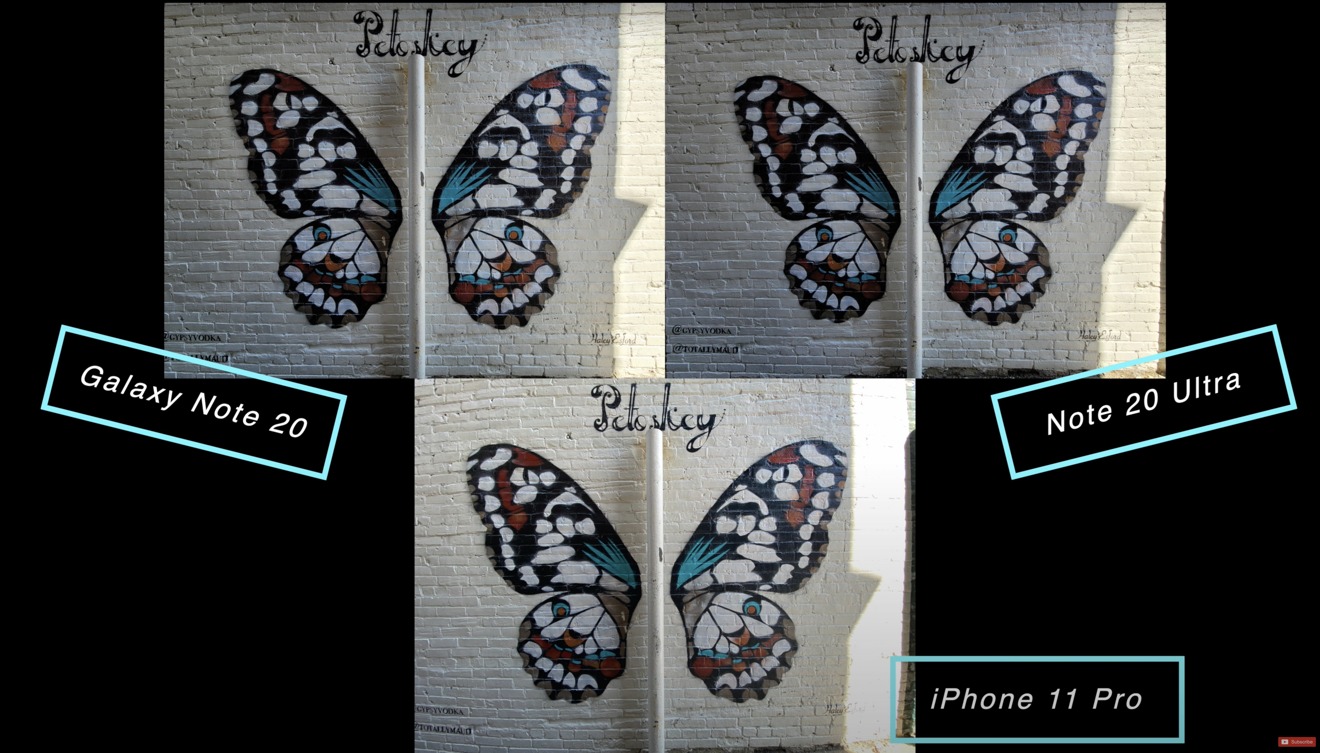

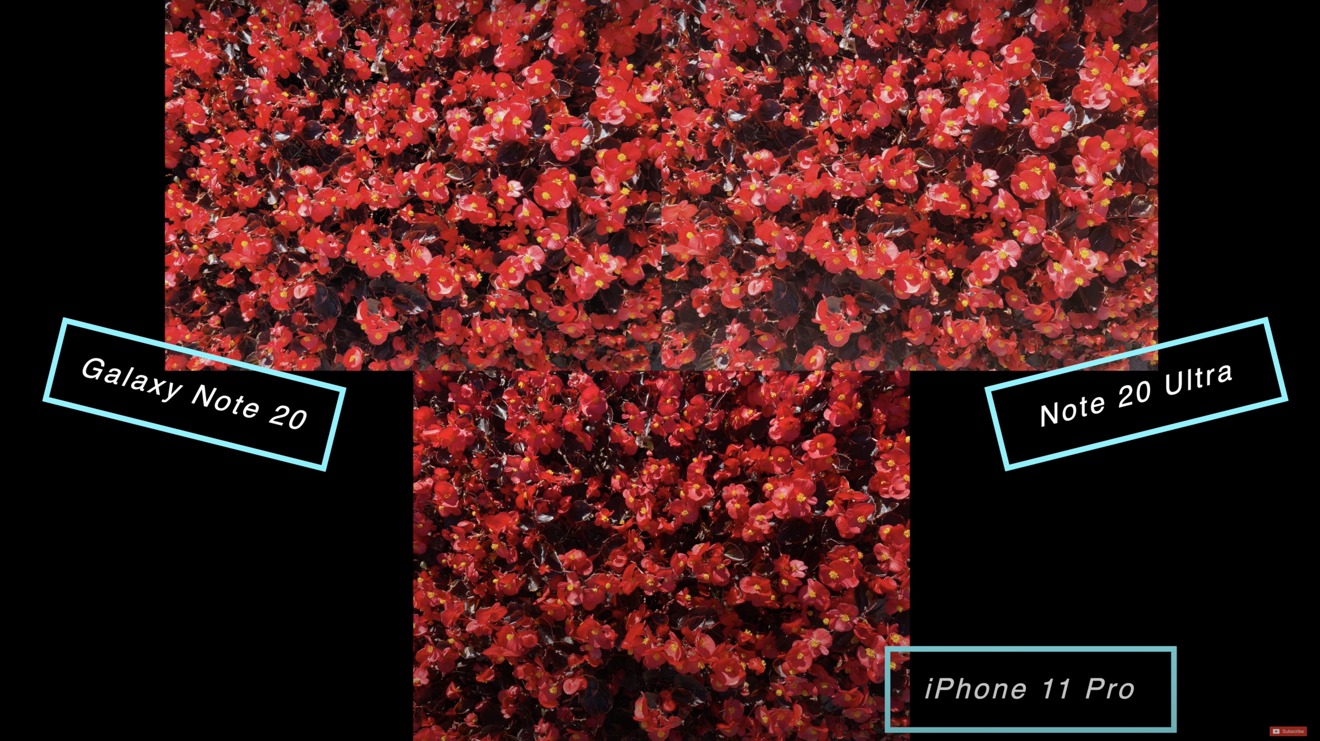

These flowers lacked contrast and were oversatured on both Note images
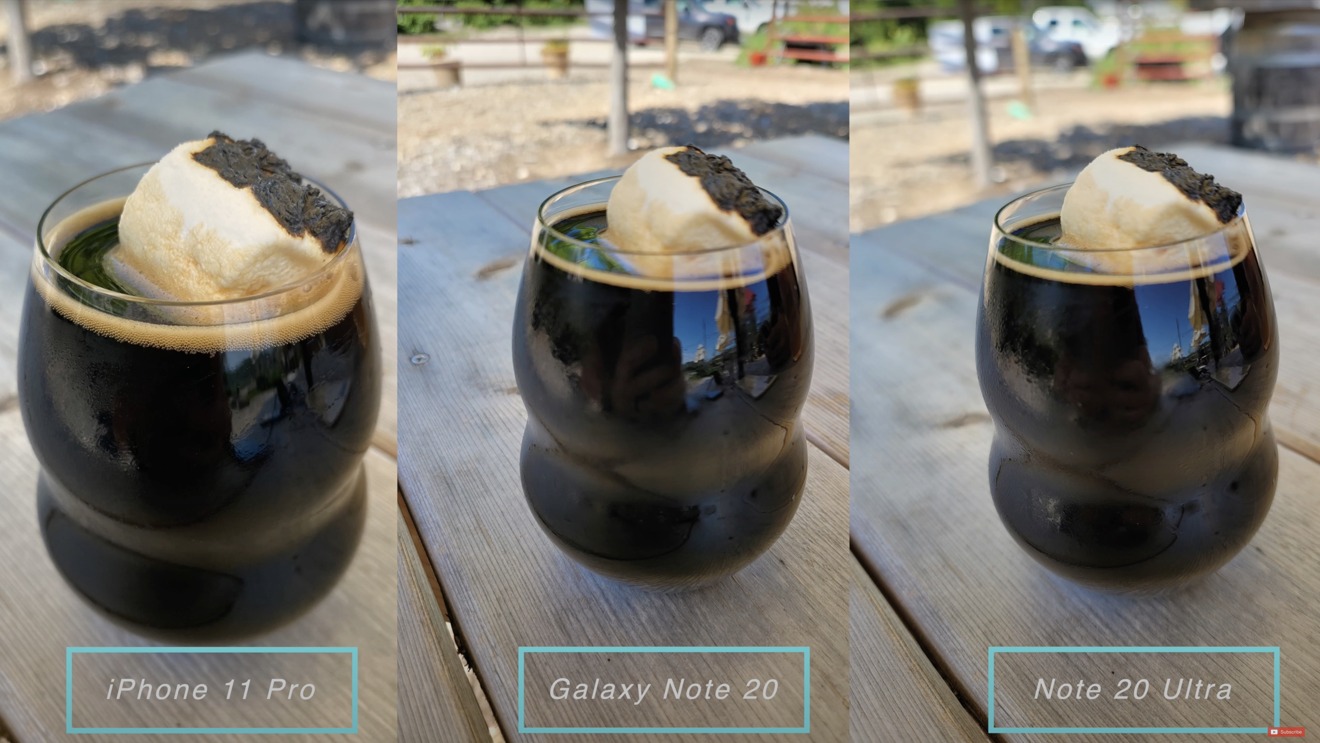

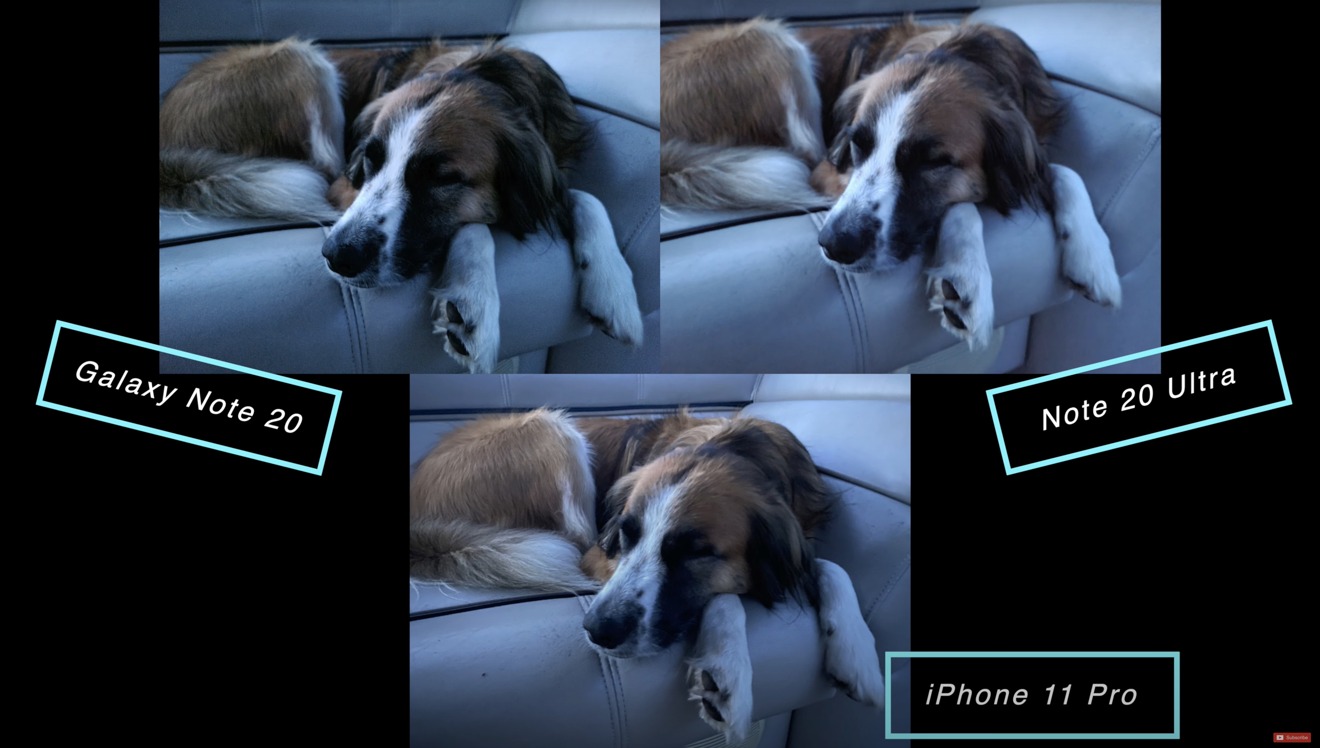

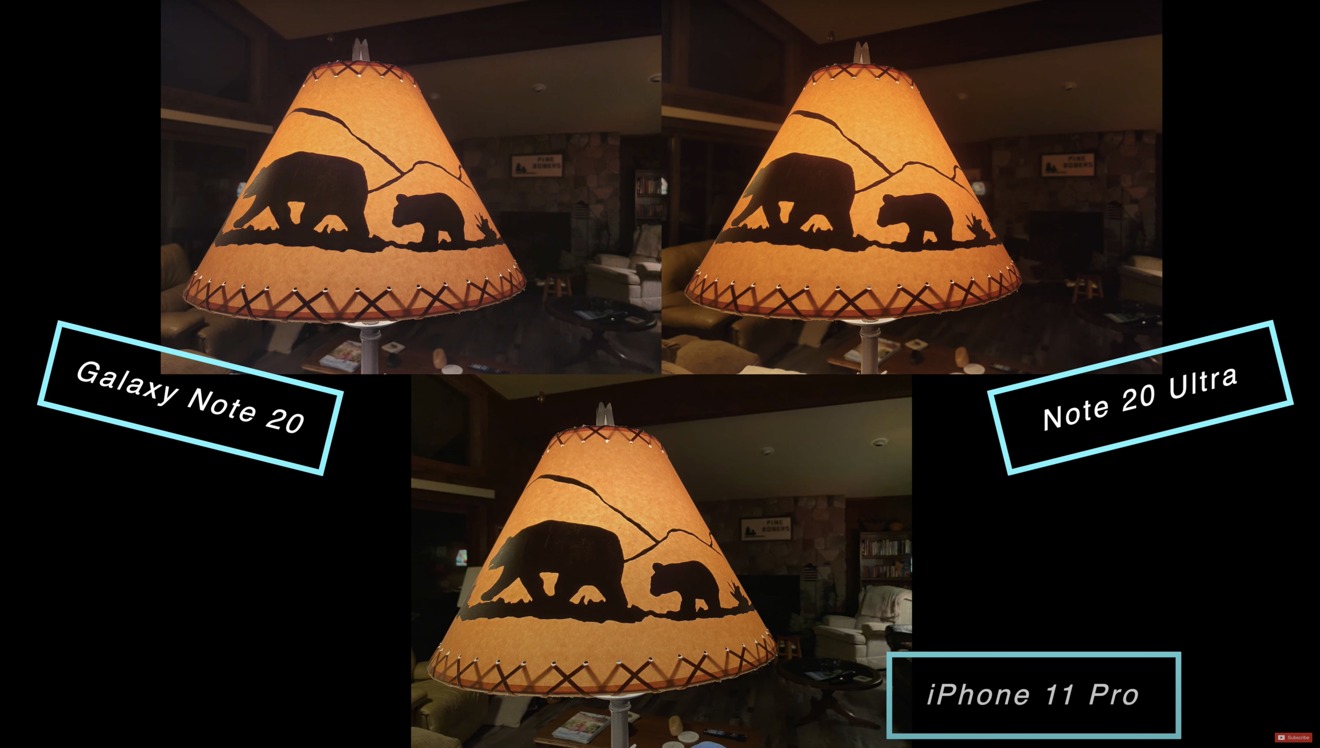

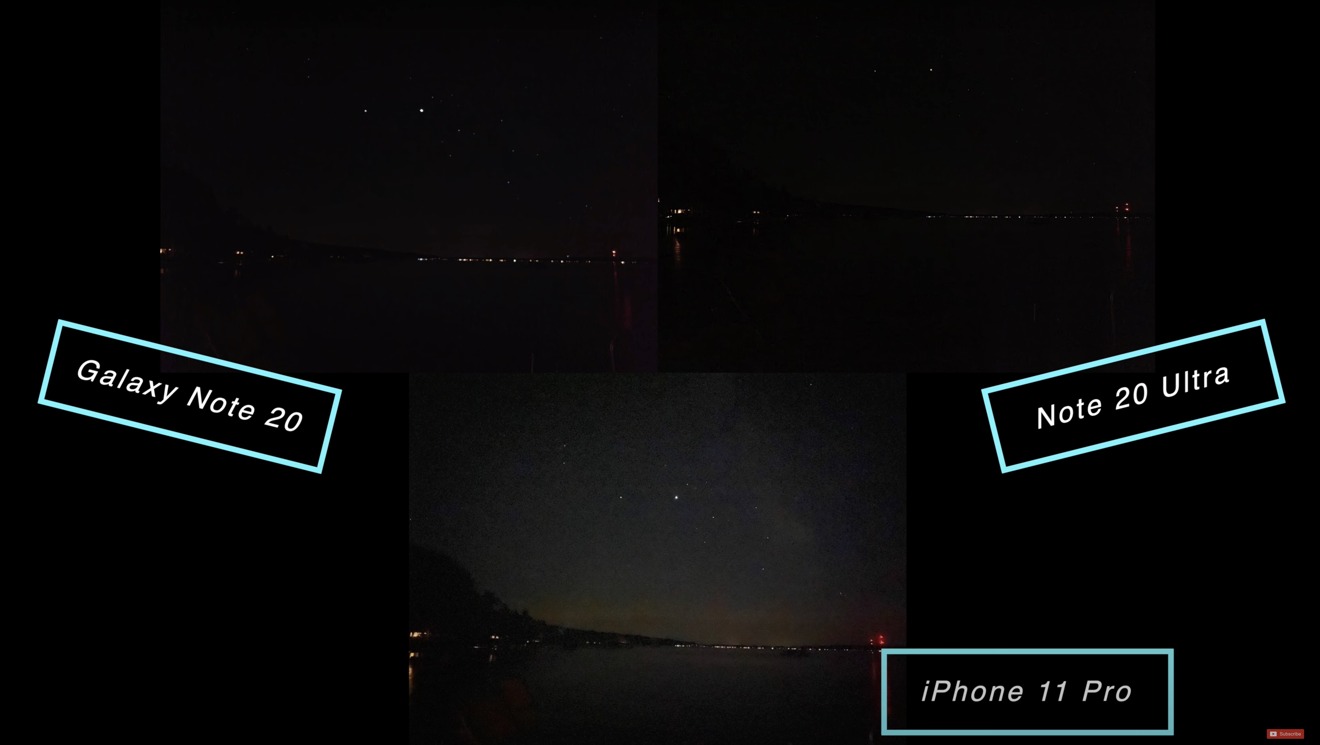

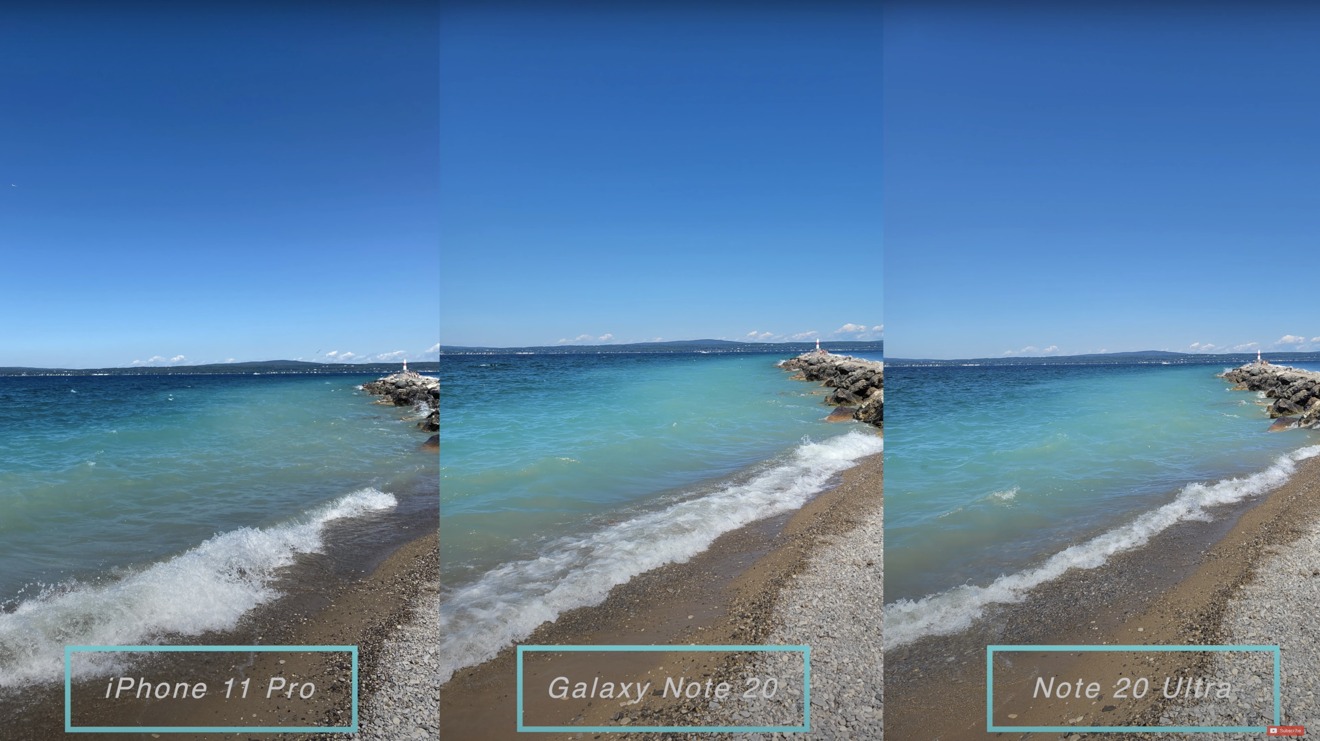

Tele capabilities
Where Samsung really shines is with the telescopic capabilities of its new devices. Both the Note 20 and the Note 20 Ultra blow away Apple in terms of picture quality.
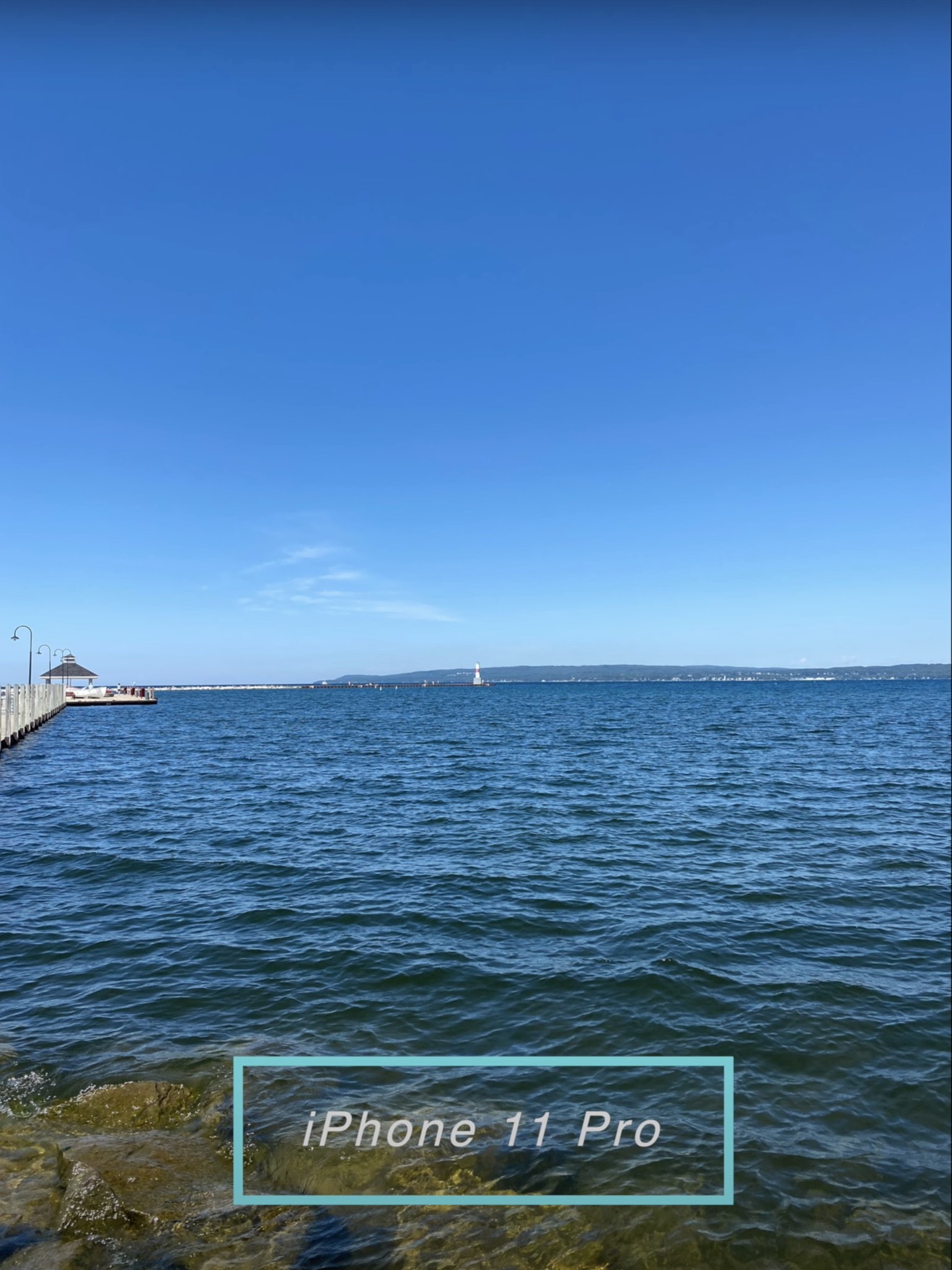

Our far away subject shot at 1X for our zoom test
In our samples, we shot a lighthouse that was a significant distance away. Our iPhone photograph at 10X looked just okay, but the Note 20 at 10X was far better due to its hybrid zoom and higher resolution tele lens.
The 50X shot from the Note 20 Ultra was sharpest at that level, though it too started to lose definition.


When we were zoomed into 50X and looked at a target that far away, it became increasingly difficult for us to keep the subject in the shot, which makes this level of zoom useless in moving situations.


We wanted to test the zoom capabilities once more, so we took some pics at a bevy of kites flying through the air. When zoomed to 50X, the iPhone’s pictures were a distorted mess, while the Galaxy Note 20 Ultra was very easy to discern what we were looking it.
It may not be sharp enough to do anything with, but in some situations, it can create very usable photos.
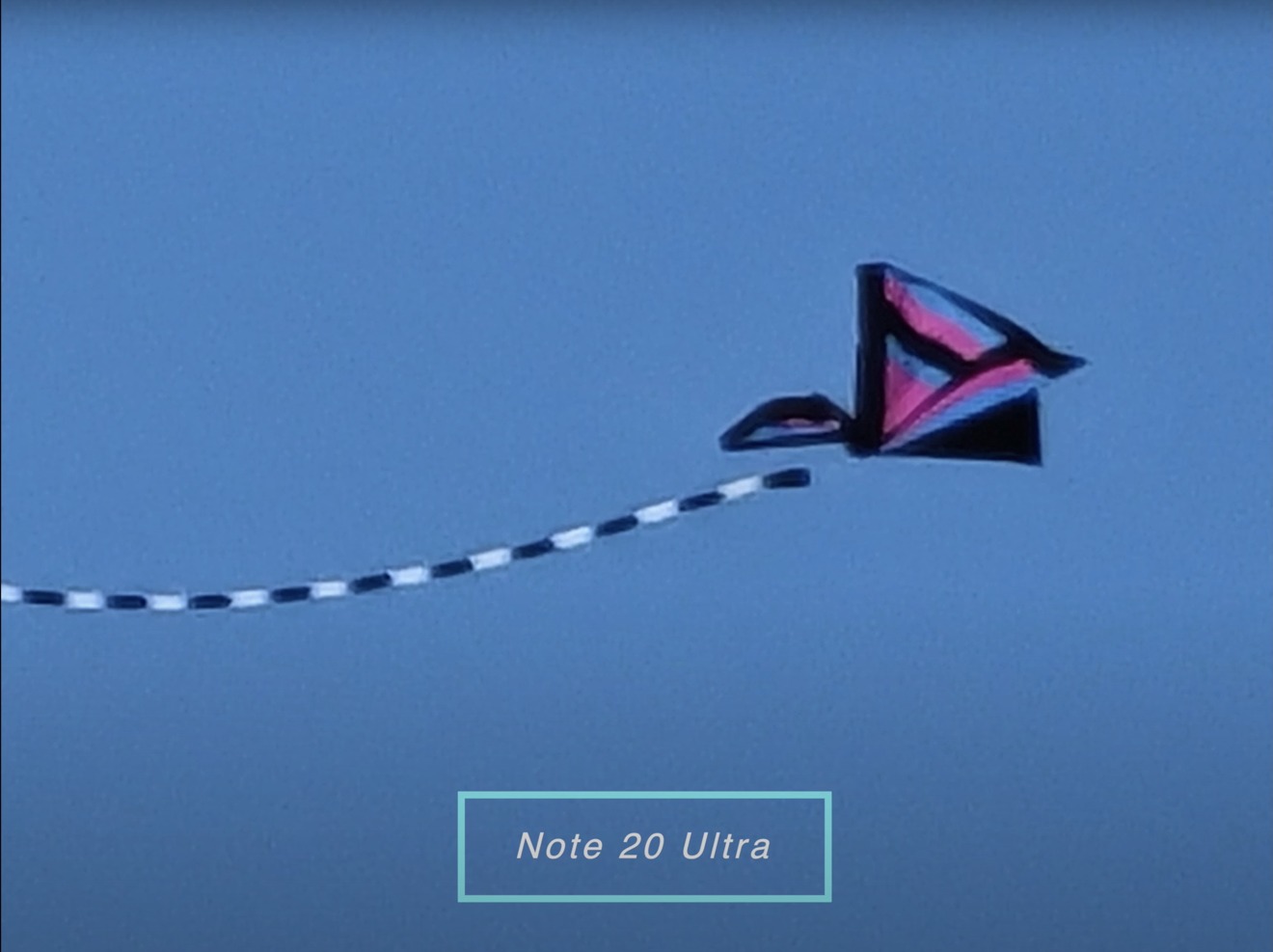

Apple’s pro cameras definitely start to look antiquated compared to these new incredible tele capabilities on Samsung’s latest phones.
Video
This camera comparison was particularly focused on the photo capabilities, but we have to at least mention video. We toyed around with this a bit and are so excited by the prospect of incredible 8K video recording coming to smartphones.
It is true that there aren’t many 8K TVs or monitors in people’s homes, but when shooting in 8K, you can crop in the video to still maintain at least 4K resolution. You’re limited to only 24 frames per second on the Notes but that is more than enough, making it a potentially invaluable tool for mobile filmmakers.
On iPhone, we are still limited to 4K at 60 frames per second. Fingers crossed we see improvements in this area on the upcoming iPhone 12.
So which is the better shooter?
Picking a winner here is hard. In everyday shots, we leaned a bit towards the iPhone the less saturated images, better focus, and better portrait mode. The overall tone of the image though can be adjusted after the fact, so if it is a white balance, contrast, or saturation issue, that can all be tweaked a bit after.


The Samsung Galaxy Note 20 and Note 20 Ultra
Samsung knocks it out of the park with the tele capabilities here. Some extreme zoom shots may be too distorted to be usable but even the 10X images look far better than the iPhone’s 10X images.
Apple very much needs to step up its game when it comes to the zoom. Apple’s strategy seems to be prioritizing your typical shots and the wide-angle lens, but if you want anything past 5X, the images very much begin to suffer in this comparison.
Where to buy
Pick up the Note 20 or Note 20 Ultra at these retailers starting at $999:
If you’d prefer the iPhone 11 Pro, these wireless carriers are offering special incentives on the device:
Tech
The Ultimate Recap of Sea Otter 2024 – Pinkbike.com


Vittoria Releases New Peyote & Mezcal XC Race Tires
Maxxis Team Spec Aspen ST Tire
New DT Swiss 240 DEG Hubs
Kali Protectives’ New Full Face Helmets
Industry Nine’s SOLiX M Hubs & Wheelsets
Michelin’s Aggressive New Wild Enduro Tires
Praxis’ New Flat Pedals, Stem, & Carbon Bottle Cage
Transmission Cage Upgrades from Kogel, Ceramicspeed, and Cascade Components
Randoms Round 1 – Sea Otter 2024
Madrone Cycles’ SRAM Eagle Repair Kits & Prototype Derailleur
Vorsprung’s New Telum Coil Shock
EXT’s Vaia Inverted DH Fork & Updated Coil Shocks
Randoms Round 2: New Tools, Goggles, Grips, Racks, & More – Sea Otter 2024
What’s New in Women’s MTB Apparel at Sea Otter 2024
Even More Randoms – Sea Otter 2024
Randoms Round 3: Dario’s Treasures
What’s New for the Kids at Sea Otter 2024
Deity Releases New Stems, Grips, & Pedals
Dario’s Final Sea Otter Randoms
Brian’s Randoms from Sea Otter 2024
Videos
With roots dating back to 1991, the Sea Otter Classic is one of the biggest biking events and tradeshows each year and brings together all sides of the biking industry from athletes to brands, spectators and consumers. Taking place in April in the sunny hills of Monterey, California, that means this event really feels like the official start to the biking season in North America. Christina Chappetta covers why it’s much different to an indoor European biking tradeshow, a World Cup racing weekend or even Crankworx mountain bike festival, in that it encompasses nearly ALL of the biking disciplines, including road cycling, enduro, downhill, dual slalom, XC, trials riding and more.
In the past fortnight, we have seen large amount of new tech releases. However, Sea Otter 2024 represents some of the first opportunities for many riders to see these things in the flesh, as well as take a deeper dive into what the product aims to do.
Welcome to a video summary from Day 2 of the Sea Otter Classic.
There are so many giveaways, interesting new products and colourful characters at Sea Otter Classic that it’s hard to stand out from the crowd. Ben Cathro takes a lap of the venue to find his favourites.
Tech
Apple iPad Air 2024: Insider Makes Hasty U-Turn On New Feature – Forbes


Well, that was quick. On May 18, a respected industry insider predicted a new display technology for the iPad Air that’s expected in the coming days—Apple just announced its latest special event.
The new 12.9-inch iPad Air, the report claimed, would have the same miniLED backlighting currently found on the larger iPad Pro, using the leftover inventory from the current Pro as that model switches to OLED. That was exciting news.
But now, Ross Young, the analyst who made the claim, has changed his mind. The new prediction, shared with paid subscribers only, is that the miniLED technology won’t be coming to the iPad Air, in either size.
While it made sense that the inventory could be maximized in this way, it now “makes sense” that it won’t.
Young says that while he’d heard from supply chain sources that it would, he’d now had contact from “even more supply chain sources” that it won’t.
And the reason this change of heart now makes sense is that this miniLED technology is expensive, so it would be surprising if it made it to the iPad Air, which is more affordable than the Pro.
That’s not quite all the analyst shared. He also said that there are now reports of a new iPad coming later in the year. This is a 12.9-inch iPad, with miniLED backlighting and it could arrive between October and December this year.
function loadConnatixScript(document)
if (!window.cnxel)
window.cnxel = ;
window.cnxel.cmd = [];
var iframe = document.createElement(‘iframe’);
iframe.style.display = ‘none’;
iframe.onload = function()
var iframeDoc = iframe.contentWindow.document;
var script = iframeDoc.createElement(‘script’);
script.src = ‘//cd.elements.video/player.js’ + ‘?cid=’ + ’62cec241-7d09-4462-afc2-f72f8d8ef40a’;
script.setAttribute(‘defer’, ‘1’);
script.setAttribute(‘type’, ‘text/javascript’);
iframeDoc.body.appendChild(script);
;
document.head.appendChild(iframe);
loadConnatixScript(document);
(function()
function createUniqueId()
return ‘xxxxxxxx-xxxx-4xxx-yxxx-xxxxxxxxxxxx’.replace(/[xy]/g, function(c)
var r = Math.random() * 16 );
const randId = createUniqueId();
document.getElementsByClassName(‘fbs-cnx’)[0].setAttribute(‘id’, randId);
document.getElementById(randId).removeAttribute(‘class’);
(new Image()).src = ‘https://capi.elements.video/tr/si?token=’ + ’44f947fb-a5ce-41f1-a4fc-78dcf31c262a’ + ‘&cid=’ + ’62cec241-7d09-4462-afc2-f72f8d8ef40a’;
cnxel.cmd.push(function ()
cnxel(
playerId: ’44f947fb-a5ce-41f1-a4fc-78dcf31c262a’,
playlistId: ‘aff7f449-8e5d-4c43-8dca-16dfb7dc05b9’,
).render(randId);
);
)();
This is intriguing. What could it be? Assuming that the iPad Pro and iPad Air are released in May, it’s extremely unlikely either will be updated later in the year. And if the iPad Air isn’t pricey enough for miniLED to be included, what tablet could Apple be introducing that is the same size as the bigger Pro, with a pricey screen tech, which would sit between the Air and the Pro, it seems?
Young is highly reliable, but this seems slightly preposterous to me. The only other iPad in the range due a refresh is the regular iPad (at 12.9-inches, the iPad mini is clearly out of the picture) and that doesn’t seem likely either.
It seems to me that any regular iPad will almost certainly have the same screen size as now, 10.9 inches. The regular iPad only grew to this size screen in the current generation, and Apple almost never changes designs after one iteration.
Perhaps things will become clearer as the year goes on.
Tech
Woman who left beaten dad on floor for 2 days was 'overwhelmed' with his care, judge told – CBC.ca


A Calgary woman who abused her sick, 77-year-old father was “overwhelmed” at the task of caring for him, a judge heard Wednesday at a sentencing hearing.
In January, Tara Picard, 52, pleaded guilty to charges of assault and failing to provide the necessaries of life after her father (whom CBC News is not naming) was found injured on a basement floor, where he’d been lying for two days.
On Wednesday, prosecutor Donna Spaner and defence lawyer Shaun Leochko asked the judge to allow Picard to serve her sentence in the community under conditions as part of a conditional sentence order.
Justice Indra Maharaj agreed to a two-year conditional sentence for Picard followed by a year of probation.
“There is no doubt she became overwhelmed,” said Spaner in her submissions. “There is no question Ms. Picard has remorse.”
Leochko told the judge that caring for her father “was really more than [Picard] could handle.”
Maharaj heard that Picard is Indigenous and was the victim of abuse growing up. She lives in a sober dorm-style facility and is working with a mental health and addictions navigator, according to Leochko.
A ‘willingness to give back’
As part of the sentence, Picard must complete 300 hours of community service.
Justice Maharaj commended Picard for “taking that on.”
“That shows me Ms. Picard sincerely does recognize what has happened here,” said the judge.
“What I interpret from that is Ms. Picard’s willingness to give back to her community.”
During Picard’s plea, court heard that in November 2021, Picard and her father fought over his drinking.
Nurses discover victim
The victim suffers from a number of medical issues, including diabetes, heart disease, dementia and alcoholism.
At the time, home-care registered nurses were assigned to help provide supplementary care.
Nurses found the victim wearing a soiled adult diaper and suffering from two black eyes with blood on his head.
He told the nurses who discovered him that he’d been there for two days.
Picard admitted she knew her father had fallen and she had “administered a number of physical blows.”
-



 Politics22 hours ago
Politics22 hours agoOpinion: Fear the politicization of pensions, no matter the politician
-



 Politics21 hours ago
Politics21 hours agoPecker’s Trump Trial Testimony Is a Lesson in Power Politics
-



 Science21 hours ago
Science21 hours agoNASA Celebrates As 1977’s Voyager 1 Phones Home At Last
-
Media14 hours ago
B.C. online harms bill on hold after deal with social media firms
-
Media20 hours ago
B.C. puts online harms bill on hold after agreement with social media companies
-
Business20 hours ago
Oil Firms Doubtful Trans Mountain Pipeline Will Start Full Service by May 1st
-



 Investment15 hours ago
Investment15 hours agoMOF: Govt to establish high-level facilitation platform to oversee potential, approved strategic investments
-
Art22 hours ago
Turner Prize: Shortlisted artist showcases Scottish Sikh community






